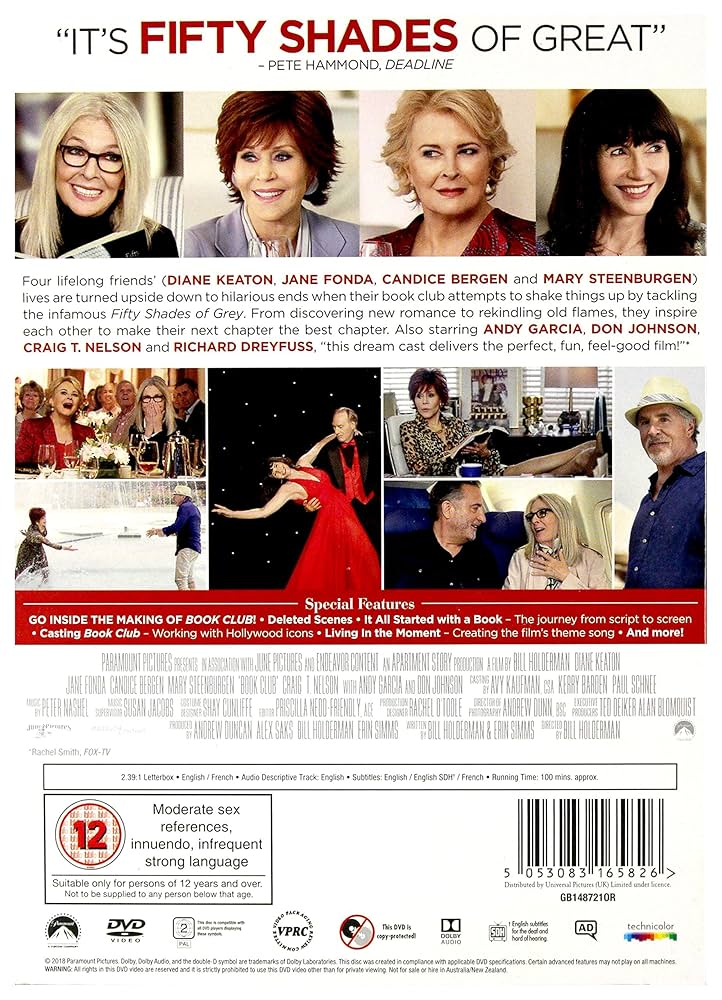Book Club Film: A Deep Dive into the Movie and Its Literary Themes

The 2018 film “Book Club,” starring an ensemble cast of acclaimed actresses including Diane Keaton, Jane Fonda, Candice Bergen, and Mary Steenburgen, offers more than just a lighthearted romantic comedy. While its surface-level plot revolves around four women whose lives are unexpectedly transformed by their book club’s choice of “Fifty Shades of Grey,” the movie delves into deeper themes of friendship, aging, sexuality, and the enduring power of literature to inspire personal growth and rediscovery. This article will explore these themes, connecting them to the broader context of books, authors, reading habits, libraries, and the cultural impact of literature, using “Book Club” as a lens through which to examine these aspects.
The Power of Shared Reading: Books and Book Clubs in “Book Club”
The film’s central premise highlights the transformative power of shared reading experiences. The four protagonists, each at a different stage of life and grappling with unique personal challenges, find solace and inspiration in their monthly book club meetings. Their choice of erotic fiction, “Fifty Shades of Grey,” initially intended as a lighthearted diversion, unexpectedly becomes a catalyst for self-reflection and personal growth. The film doesn’t shy away from depicting the varied responses to the book, showcasing the individual interpretations and reactions that shared reading can evoke. This dynamic speaks volumes about the subjective nature of literary engagement and the different ways in which books can resonate with individuals based on their personal experiences and life stages.

The film’s focus on a book club implicitly highlights several important aspects related to books and their genres. While “Fifty Shades of Grey” is the central text, it serves as a springboard for discussions of diverse genres. The film subtly touches upon the appeal of different genres, from romance and erotic literature to potentially more literary or classic works, implicit in the women’s reading choices throughout their lives. The contrast between the unexpected choice of “Fifty Shades” and the implied presence of other, perhaps more “traditional,” book club selections emphasizes the breadth of literature and the diverse experiences it can offer. The movie acknowledges the way bestsellers can influence reading choices and introduce unexpected perspectives, even for those already established in their reading routines.
Furthermore, the book club’s impact extends beyond mere entertainment. The film touches upon the educational value and life lessons embedded within literature, suggesting that books can offer insights into human relationships, personal growth, and self-discovery. The women’s discussions, though often comedic, reveal deeper truths about their desires, fears, and hopes. The film illustrates the way a book can be a launching point for personal evolution, prompting readers to re-evaluate their priorities, challenge assumptions, and embrace new possibilities. It subtly highlights how reading habits, both individual and shared, can contribute to personal enrichment and meaningful connection.

“Fifty Shades” as a Catalyst for Change: Exploring Erotic Literature and its Reception
The selection of “Fifty Shades of Grey” is not arbitrary. It serves as a provocative catalyst, challenging the perceived limitations of aging and sexuality. The film’s portrayal of these women embracing their sexuality and desires after a certain age counters societal stereotypes and normalizes the exploration of intimacy and pleasure across all life stages. It suggests that age doesn’t diminish the need for passion or exploration and allows the characters to explore the complex relationships between pleasure, identity, and personal fulfillment, demonstrating how literature can challenge social norms and spark important conversations.
The film’s exploration of erotic literature also raises questions about literary censorship and the varied interpretations of “Fifty Shades.” The reactions of the book club members showcase the diverse ways in which a single text can be received and interpreted, highlighting the subjective and personal nature of literary experiences. The film indirectly touches on the ongoing debates about representation and social norms within literature, suggesting how a single book, often viewed as controversial, can spark significant conversations and challenge traditional boundaries.
The Authors Behind the Words: Exploring Literary Inspiration and Impact

While the focus is on the book club’s collective reading, the film subtly underscores the creative processes and personal experiences that shape literary works. By indirectly referencing the author of “Fifty Shades of Grey”, the film alludes to the authors behind the book and their own influences. It’s a reminder that literature is born from the lived experiences and unique perspectives of its creators. It prompts reflection on the authors’ biographies, writing styles, and sources of inspiration. The movie serves as a springboard for contemplating the connections between an author’s life and their work.
The film’s success, in part, stems from its skillful use of well-known actresses, each with established public personas and rich histories in film. This implicitly draws parallels between the authors’ personal lives and fictional worlds, underscoring how a writer’s life can inform their creative output and generate interest in exploring the individual authors behind the popular books.
Beyond the Pages: Libraries, Archives, and the Cultural Impact of Literature
The film’s setting—primarily the homes of the protagonists and occasionally implying public spaces—suggests the importance of libraries and archives in preserving and disseminating literature. While not directly depicted, the implicit access to these books highlights the role of libraries, both physical and digital, in making literature accessible to a wide audience. The film’s portrayal of the book club’s discussions in their respective homes points to the growing role of digital libraries and online access to literary works and their impact on reading habits.
The film’s impact itself becomes a testament to the cultural influence of literature and its adaptations into other media. “Book Club” is a cinematic adaptation of a shared reading experience, suggesting that literature can inspire new narratives and creative interpretations. The film’s successful translation of literary themes onto the screen suggests the broad appeal of shared literary experiences and the enduring influence of books on culture, creativity, and personal expression.
Celebrating Female Friendship and Aging: “Book Club” and its Cultural Resonance
“Book Club” is more than just a story about reading. It’s a celebration of female friendship and a poignant exploration of aging. The film’s central theme is the enduring power of friendship and how it can weather life’s storms, underscoring the significance of social communities and support networks. The movie’s portrayal of older women actively participating in their own lives challenges prevailing narratives, highlighting the enduring capacity for growth, renewal, and joy at all ages.
The film’s portrayal of women embracing their sexuality and relationships in later life is a powerful statement against ageism. The movie depicts these women reclaiming their identities and challenging societal norms, thereby indirectly highlighting the lasting cultural impact of literature on how we view various stages of life and social structures.
The “Book Club” Phenomenon: Communities and Literary Influence
The film’s success reflects the broader cultural phenomenon of book clubs and their ability to foster social interaction and intellectual engagement. The movie showcases the positive aspects of shared literary experiences, promoting discussion and personal growth. It’s a subtle nod to the widespread literary communities and their importance in promoting critical thinking and social connectedness.
The film’s thematic exploration of friendship, sexuality, and aging, filtered through the lens of a book club, has resonated with audiences, leading to discussions and interpretations beyond the initial storyline. This demonstrates the power of literature to inspire conversations and impact cultural discourse.
Conclusion: The Enduring Appeal of “Book Club”
“Book Club” may appear to be a simple romantic comedy, but a closer look reveals a rich tapestry of interwoven themes exploring the enduring power of literature, the importance of friendship, and the ongoing relevance of embracing life’s adventures at any age. By focusing on a shared reading experience, the film deftly touches upon several facets of literary culture, from the subjective nature of interpretation to the diverse genres and authors that contribute to a rich literary landscape. It’s a film that encourages reflection on the transformative power of books and the lasting impact of shared experiences on personal growth and community building. Ultimately, “Book Club” serves as a charming reminder of the enduring appeal of literature and the richness it can bring to our lives.